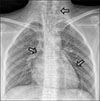A 21-year-old female with type 1 diabetes mellitus presenting with a one-day history of headache, nausea, and vomiting was admitted to the emergency room. After multiple episodes of vomiting, she complained of sore throat and chest tightness. At the time of admission, her blood pressure was 100/60 mmHg, and her heart rate was 102 beats/minute. Her breathing was deep, rapid, and labored with a respiratory rate of 20 breathes/minute. The patient's body temperature was 37.4℃. On auscultation of her chest, a systolic crunching and popping sound was heard at the cardiac apex and at both sternal borders (Hamman's sign). Laboratory findings showed high anion gap metabolic acidosis with an arterial blood pH of 7.23, serum glucose level of 588 mg/dL, bicarbonate level of 4.6 mmol/L, and serum ketone level of 12,757 µmol/L. A chest radiography showed mediastinal air along both cardiac borders and extending along the anterior mediastinum up both sides of the neck (Fig. 1, 2).
Diabetic ketoacidosis (DKA) with a spontaneous pneu momediastinum was diagnosed. Accordingly, we started insulin and fluid therapy. After glucose control and conservative therapy, she was discharged in good condition. The pneumomediastinum resolved spontaneously while she was admitted for the treatment of DKA.
Spontaneous pneumomediastinum is a rare complication of DKA. In severe DKA, vomiting and Kussmaul breathing may induce alveolar rupture due to increased intra- alveolar pressure.1 The incidence of chest pain complaints is lower in cases of pneumomediastinum accompanied by DKA than in cases of generalized pneumomediastinum, and dyspnea can be regarded as a symptom of DKA; this increases the chances of missing the correct diagnosis.2 Pneumomediastinum associated with DKA has a benign course and the treatment is supportive. However, life-threatening complications (pneumothorax, pneumopericardium, and mediastinitis) might accompany this condition. Therefore, clinicians need to include this complication in the differential diagnosis.




 PDF
PDF ePub
ePub Citation
Citation Print
Print




 XML Download
XML Download